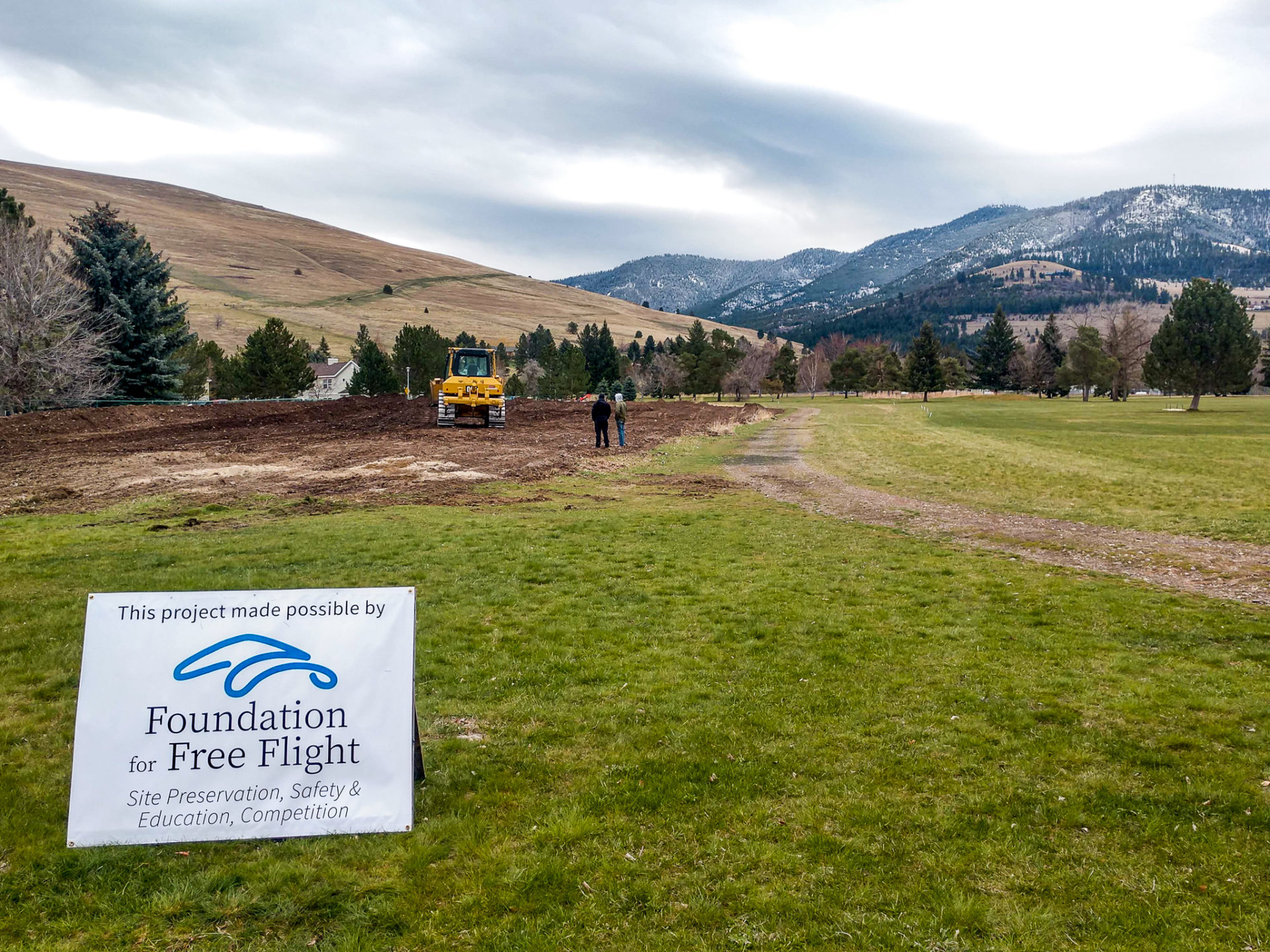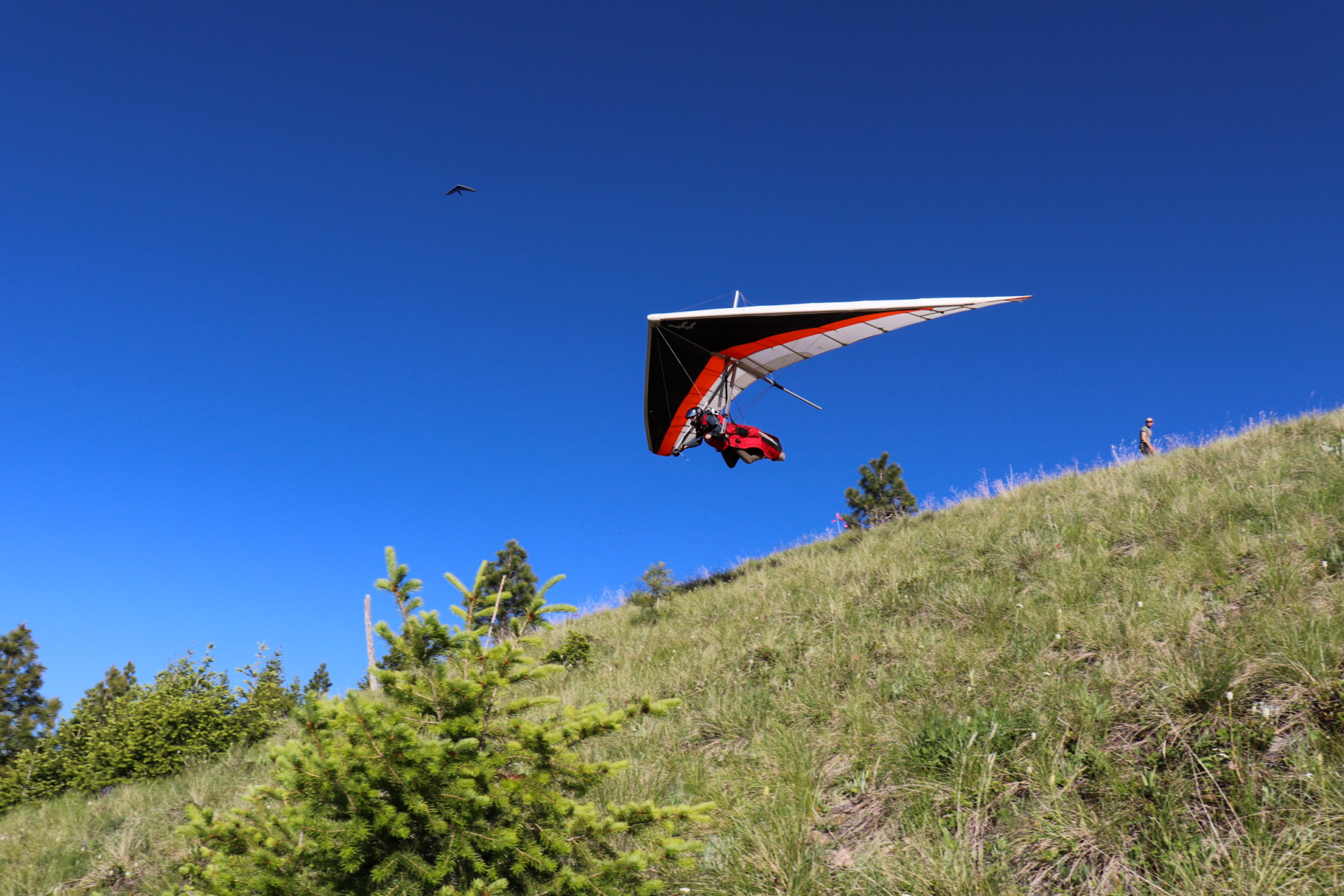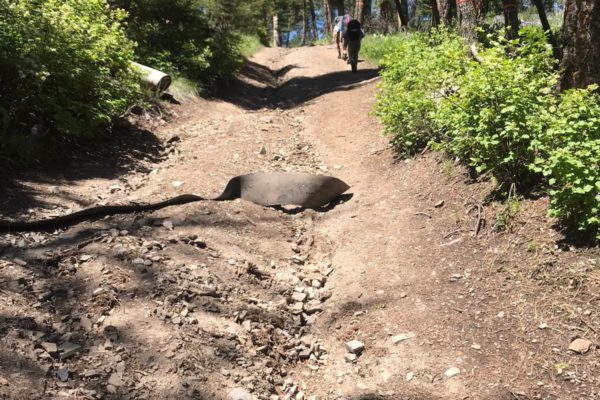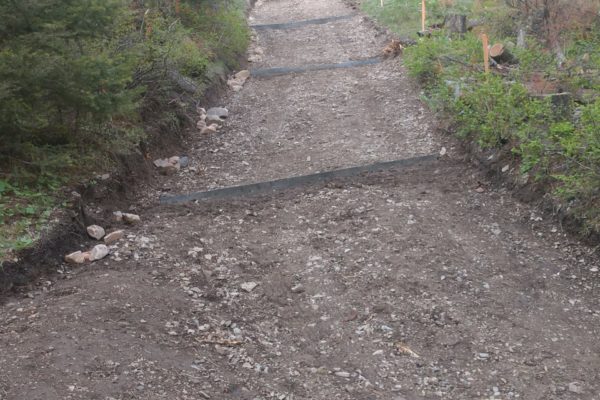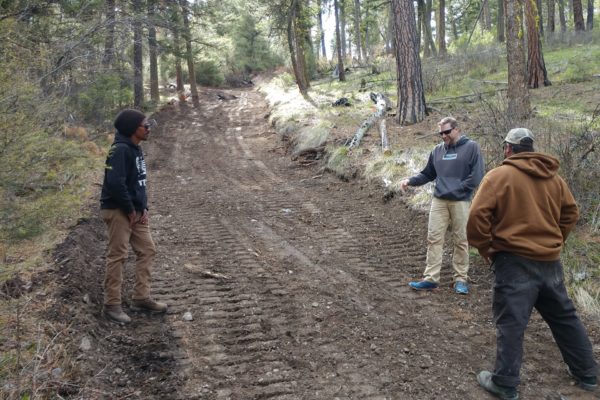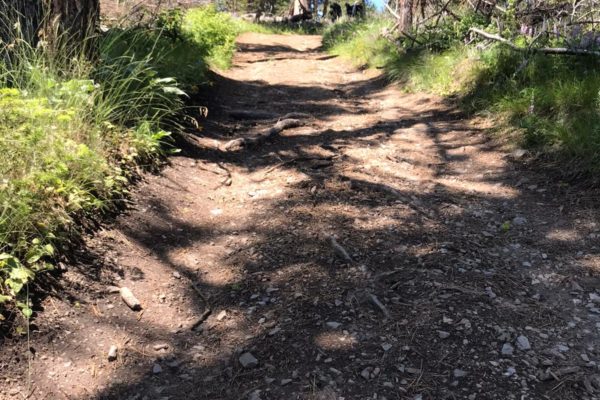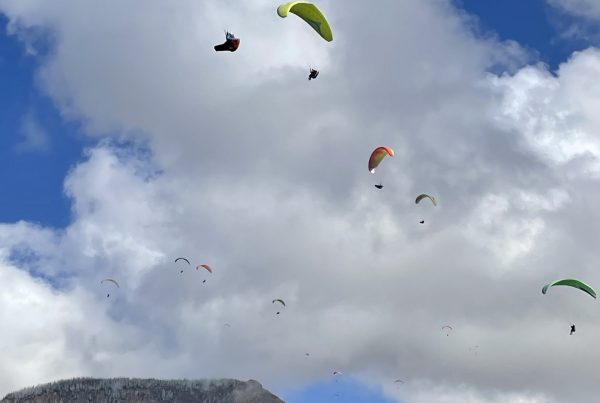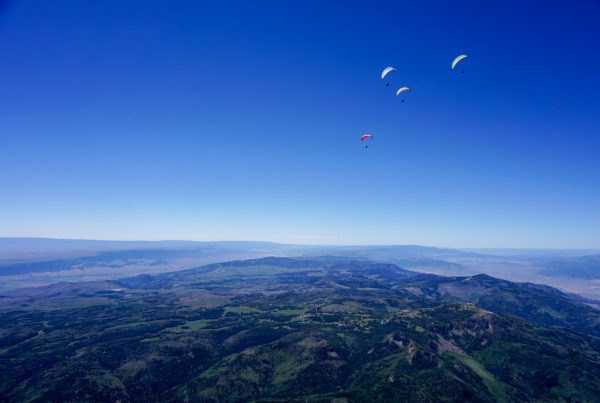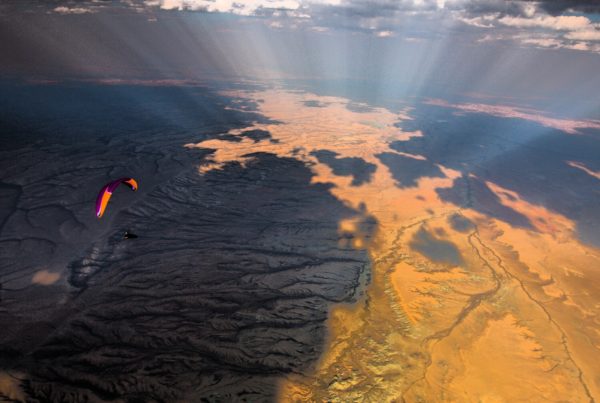by Joshua Phillips
The voice in my head repeats: “WALK-JOG-RUN”, “WINGS LEVEL”, “BREATHE!” My mentors (Paul and Karl) on my wires, I can’t believe I’m about to fly over my town …from a mountain I’ve been looking up at for 25 years. I’m humbled and feeling small, but confident and certain of purpose at the same time. “CLEAR!” One step forward and I know there is no going back now. My hang strap goes tight as I accelerate and in a moment I’m thousands of feet over the Clark Fork River and Interstate 90. As I bank left over Missoula, a city of 75,000 inhabitants, I wonder if anyone I know is looking up at me. The flight is short, just a morning sled ride, and after a well-timed flare I’m on the ground…vibrating with excitement in the LZ. I’ve done it now: I’ve flown a hang glider off of Mt. Sentinel’s iconic summit. I feel tears well up as I think, “My dream has been realized and I will never be the same.”
Nearly 30 years ago I first laid eyes on what is now my home flying site: Mt. Sentinel. I had come to Missoula, Montana for college and remember picking up my University-published planner called the Bear Facts. On the cover appeared the school mascot, Monte (a cartoon Grizzly Bear), flying a hang glider high above the “mountain with the M on it.” Having arrived with still-potent childhood dreams of flight, when I saw that hang gliding bear, I knew I had come to the right place. As fortune would have it, 24 years would pass before I first flew from the bald summit of Mt. Sentinel. And little did I know at the time, I would be flying a paraglider, the hang glider to follow a couple years later.
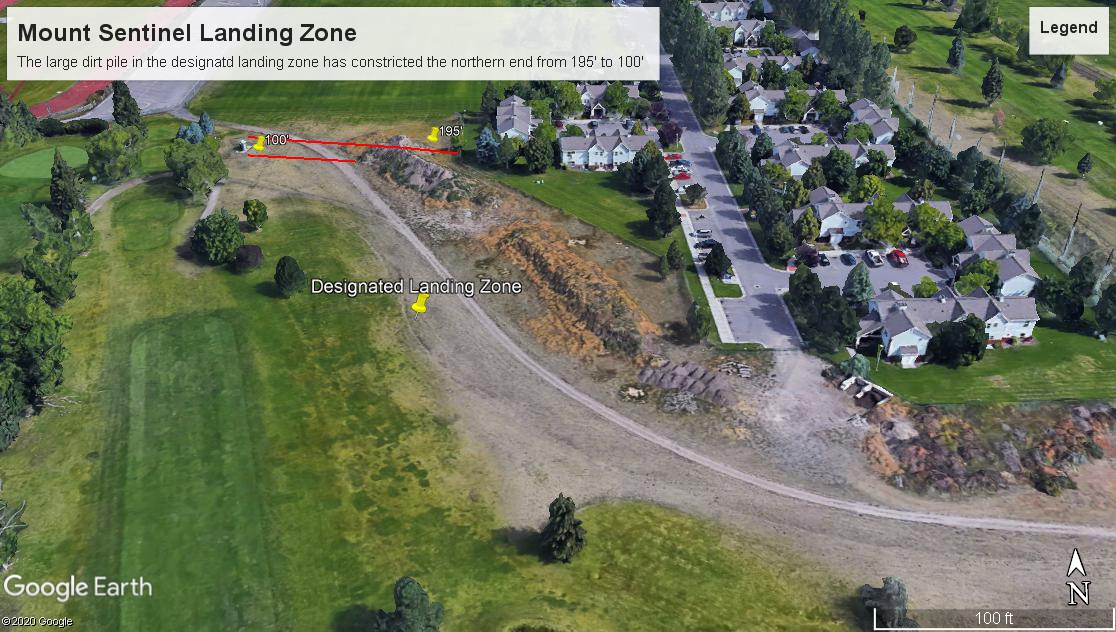
Once a part of the local free flight community, I learned that Mt. Sentinel possesses a long history of free flight; holding the title as the oldest registered inland hang glider launch in the U.S. bold Rogallo pilots launched from her flanks as early as the 60’s, and Missoula’s convergent winds and large valley continue to offer smooth and consistent, almost coastal conditions on the grassy west-facing site. Unlike many flying sites, Sentinel is complicated by four agencies involved in its functionality: The City of Missoula, the University of Montana, the U.S. Forest Service, and Missoula International Airport Air Traffic Control (who we must call before heading up the mountain.) Visiting pilots are often caught off-guard by the many rules and site protocols we have grown accustomed to, but I guess it is the price we pay to fly such a legendary site at the edge of town and just minutes from our homes.
To fly a hang glider from the University-owned summit, a pilot must drive a truck (slowly, with USFS Special Use Permit hardcopy on the dashboard) up Crazy Canyon Road, a gated shared-use dirt two-track, enjoyed by many dog walkers, hikers, runners, and mountain bikers. In mid-summer, many a paraglider pilot will opt for the 30 minute ride up Crazy Canyon over the hour-long slog on the scorching treeless west face of Mt. Sentinel, angled like a solar panel in the midday sun. The possibility of driving up to launch is mandatory for any disabled pilot or tandem passenger that would like to enjoy free flight in Missoula.
At the boundary between Forest Service and University land, the road turns into a steep 4×4 jeep trail for the final ½ mile and 300 foot climb to the summit launch site. It was this eroded and deeply rutted stretch that University legal staff deemed as “unsafe for use” and closed in the spring of 2020, just as we were getting excited about driving our gliders to launch.
And so the effort began: to rehabilitate the jeep trail and regain access road access to the top of Mount Sentinel. Club members Paul Roys and Karl Hallman proposed a project to the Foundation for Free Flight to not only rehabilitate the road, but also restore the landing zone by removing an increasingly large dump site and dirt pile. Remnants from construction of the University’s softball field had greatly constricted the final approach window to about two hang glider widths, prompting an increase in rating requirement for hang glider pilots due to the new hazard in the landing zone. I will skip the boring details here, but getting this project off the ground involved an incredible amount of time and energy invested by the above-mentioned pilots. The bottom line is, without the generous funding from the Foundation for Free Flight, this project would not have come to fruition. The roadwork and LZ restoration not only involved the costly expense of a heavy equipment contractor, but also pro bono time from a local arborist (Emily Garlough of Missoula Tree Preservation) for tree removal and a civil engineer (Tom Anderson of Eli & Associates) for design consultation. In addition to all of this, the final push to completion involved club members who volunteered hours of labor to install water bar erosion control on the road.
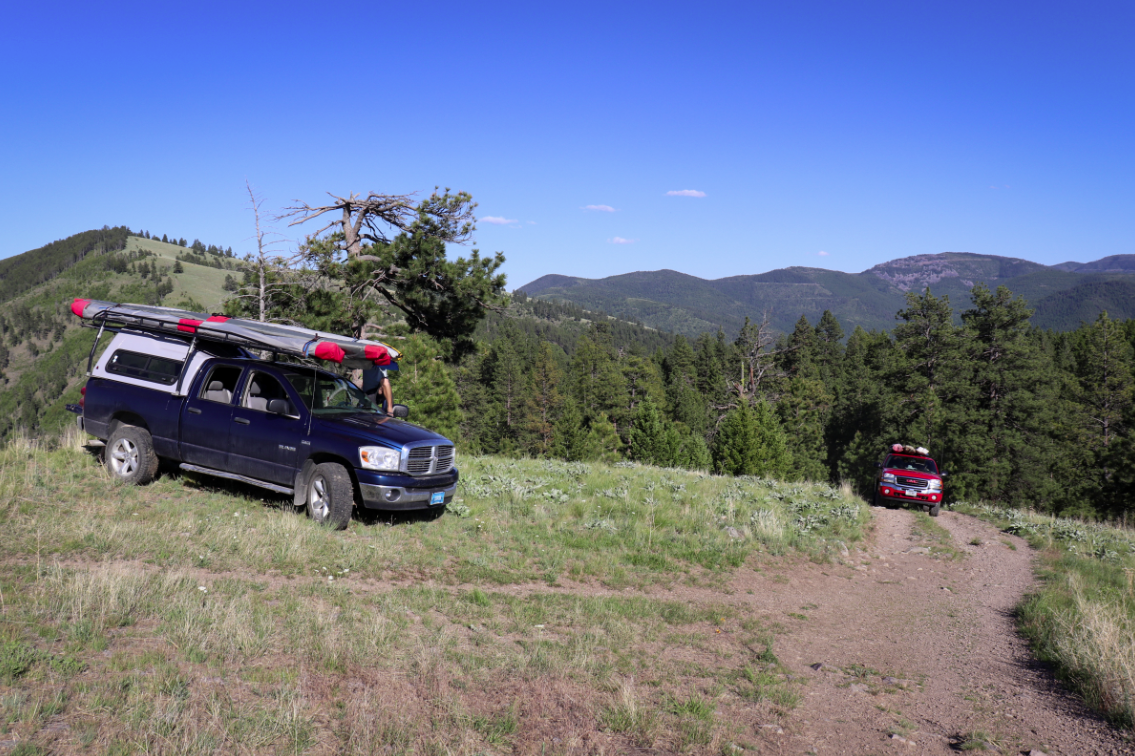
The road and LZ rehabilitation project was completed this spring, just in time to celebrate the 50th year of free flight on Mt. Sentinel! After allowing a couple of weeks of rain to mitigate dust and settle the newly graded road, I enjoyed a ride to the top in a truck stacked with gliders and full of smiling pilots, ready to again realize our dreams and fly from the top of Mt. Sentinel. This project would not have been possible without the generous donation from the Foundation for Free Flight, and all of the past, present, and future pilots of Missoula can’t say “thank you!” enough for helping reopen our home site.
Many newer pilots don’t realize that “free flight” isn’t really free. I was oblivious to what it takes to keep a site operational when I was a fledgling. Site preservation and maintenance takes an incredible amount of time and effort and the “heavy lifting” of site preservation is often performed by a small handful of dedicated pilots. These invaluable members of our flight community spend their free time dealing with local politics, bureaucracies, land owners, contracts, and funding; none of which any sane pilot would call fun. One thing I’ve learned about free flight is that we are all connected through our common interest. Most pilots enjoy visiting new sites and connecting with locals for a site briefing or going to fly-ins or competitions to experience other flying environments. So, how do you get involved in site preservation and maintenance without sacrificing all of your airtime? Well, a donation to the Foundation for Free Flight is a great start!
